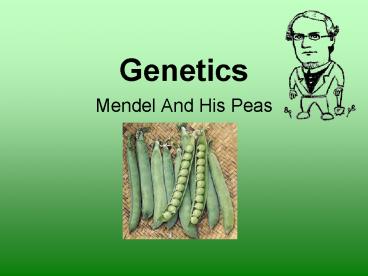Genetics - PowerPoint PPT Presentation
1 / 34
Title:
Genetics
Description:
Genetics Mendel And His Peas He was a mathematician and statistician he was better able to analyze his data. He worked with large ... – PowerPoint PPT presentation
Number of Views:87
Avg rating:3.0/5.0
Title: Genetics
1
Genetics
- Mendel And His Peas
2
Genetics the scientific study of heredity
- Gregor Mendel 1800s
- His monastery garden pea plant experiments
laid the foundations of the science of genetics.
3
Summary of the pea plant experiments
- 1) Mendel developed pure-bred (true-breeding)
plants by allowing plants to self-pollinate.
(always produce identical offspring)
4
In order to discuss whats next we must look at
the structure of a pea plant flower
5
- (a) stigma traps pollen e) stamen
anther filament - (b) anther makes pollen (f) carpel (or
pistil) -
stigma, and style - (c ) ovary eggs and seeds g) sepal (bud
leaf) - form here
- (d) filament lifts anther
6
- 2) Mendel crossed-pollinated pure bred plants and
then crossed their offspring. (anther cut off one
plant to eliminate its pollen, and then dusted
pollen from another plant.)
7
(No Transcript)
8
- 3) After numerous
- experiments,
- Mendel analyzed
- data and drew
- conclusions
- about
- inheritance.
9
(No Transcript)
10
(No Transcript)
11
(No Transcript)
12
WHAT EXACTLY DID MENDEL DO?
- First, Mendel crossed a pure-bred (true
- breeding) TALL plant with a pure-bred SHORT
plant. - Result The offspring were all TALL.
about 6 feet tall
under two feet
13
- Second, Mendel crossed two of the TALL
offspring. - Result ¾ of the offspring were TALL
- ¼ of the offspring were SHORT
14
- (This same result happed
- for other characteristics
- such as seed shape,
- seed color, position
- of flowers etc.
- --pg 264) Seven
- pea plant traits
- studied by Mendel
15
WHY DID THIS HAPPEN?
- Mendel found that some
genes for specific traits
are dominant over other
genes. - Contrasting genes for a
particular trait are called
alleles, so they are dominant
alleles. - The genes that are not expressed because dominant
alleles are present, are said to be recessive
alleles.
16
Using Punnett Squares to explain Mendels
results
- They were
- developed by
17
(No Transcript)
18
- Actual pollen grains
19
(No Transcript)
20
(No Transcript)
21
(No Transcript)
22
(No Transcript)
23
(No Transcript)
24
(No Transcript)
25
- Try this
- What if Mendel crossed an
F1offspring
pure-bred tall - (heterozygous) with a (homozygous)
plant. - X
- What would be the phenotypic genotypic ratios?
26
(No Transcript)
27
(No Transcript)
28
(No Transcript)
29
(No Transcript)
30
Monohybrid Dihybrid Crosses
31
(No Transcript)
32
- The principle of dominance some alleles are
dominant and some are recessive. Dominant allele
blocked the expression of recessives. (Mendel
called alleles or genes factors)
33
- The principle of segregation alleles separate
during the formation of gametes. - The principle of independent assortment- genes
for different traits can segregate independently
during the formation of gametes. - (where one allele goes does not affect where the
other goes.)
34
- He was a mathematician and
- statistician he was better
- able to analyze his data.
- He worked with large
- numbers of plants etc..
- He luckily chose plant traits to
- observe, in which the alleles for
- those traits were on separate
- chromosomes, or at least not
- close together.































